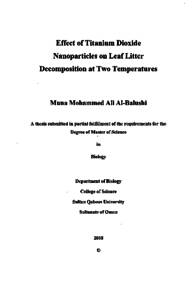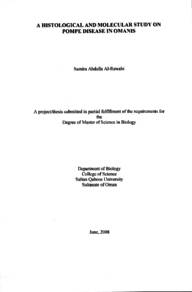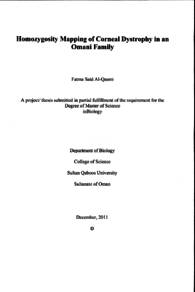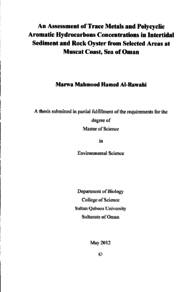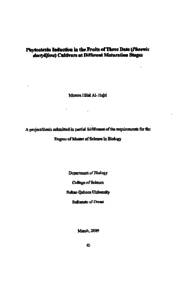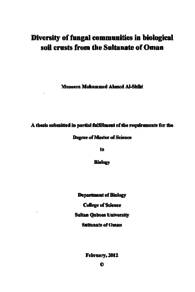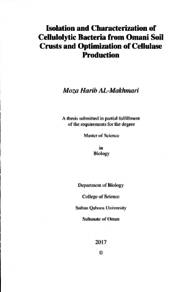Document
Effect of titanium dioxide nanoparticles on leaf litter decomposition at two temperatures
Publisher
Sultan Qaboos University
Gregorian
2018
Language
English
Subject
English abstract
The use of nanoparticles is increasing worldwide. In particular, titanium dioxide nanoparticles (TiO2-NPs) have received considerable attention due to their extensive use. Temperature plays an important role as a modulator of biological processes. The aim of this study was to investigate the toxic effects of TiO2-NP on the decomposition of leaf litter and on the activity (respiration rate and enzyme activity) and diversity of microbial communities associated with decomposition of Ficus sycomorus leaves at two temperatures.
During the experiment, the effect of four different concentrations (0, 1, 10, 100 mg/L) of TiO2-NP on leaves decomposition rate was measured at two different temperatures (25-26°C and 33-35 °C) in three incubation periods (2, 4, 6 weeks). The effects on percentage mass loss, respiration rate and bacterial and fungal count were measured in the three periods. The effects on enzyme activity, biomass of filamentous algae and bacterial diversity were measured only after six weeks of incubation. Both TiO2-NP concentration and temperature affected leaf decomposition rate in weeks two and four, By week six, there was no significant effect because leaves already decomposed. Also, there was a significant direct effect of time on percentage mass loss. The respiration rate of microbes associated with Ficus sycomorus leaves was significantly affected by time of exposure, NP concentrations and temperature. The overall bacterial and fungal counts associated with leaf were very low. No significant effect of NP concentrations and exposure periods was observed on bacterial count but there was a significant effect of temperature on bacterial count as the bacterial count in high temperature was higher than in low temperature. However, there was no significant effect of NP concentration or temperature on the fungal count and biomass of algae. The data from MiSeq Illimina sequencing of the bacterial communities found 5895.8 operational taxonomic units (OTUS) that corresponded to 7 classes, 20 genus, and 28 species. Bacterial species number and species richness estimates increased at high temperature and there are higher class and genus variations in high temperature treatments than in low temperature. Bacteria belonging to class Alphaproteobacteria were found to be the dominant class at both high and low temperatures.
Our findings indicate that bacterial activity and diversity could be used as environmental indicators to assess the contamination of aquatic ecosystems with NPS and that the change of environmental conditions particularly rises in water temperature might increase the negative impacts of the nanoparticles.
Member of
Resource URL
Arabic abstract
أن استخدام الجسيمات النانونية يزداد في جميع أنحاء العالم. وعلى وجه الخصوص ، جسيمات ثاني أكسيد التيتانيوم النانوية التي حظيت باهتمام كبير نظرا لاستخدامها المكثف. تلعب درجة الحرارة دورا مهما كمحرك للعمليات الحيوية. كان الهدف من الدراسة هو دراسة التأثير السام لجسيمات ثاني أكسيد التيتانيوم على تحلل الأوراق وعلى نشاط (معدل التنفس ونشاط الإنزيم) وتنوع المجتمعات البكتيرية المرتبطة بتحلل أوراق الجيمز عند درجات حرارة مختلفة. خلال التجربة ، تم قياس تأثير أربعة تراكيز مختلفة (0، 1، 10، 100 ملغرام/لتر) من جسيمات ثاني أكسيد التيتانيوم النانونية على معدل تحلل الأوراق عند درجتي حرارة مختلفتين (25-26 درجة مئوية و33-35 درجة منوية في ثلاث فترات احتضان (2، 4، 6 أسابيع). تم قياس التأثير على النسبة المئوية لخسارة الكتلة ومعدل البكتيريا والفطريات في الفترات الثلاث تم قياس التأثير على نشاط إنزيم بيتا-جلوكوزيديز والكتلة الحيوية للطحالب الخيطية والتنوع البكتيري فقط بعد ستة أسابيع من الاحتضان. أثر كل من تركيز الجسيمات النانونية ودرجة الحرارة على معدل تحلل الأوراق في المراحل المبكرة من الاحتضان (الأسبوعين الثاني والرابع). في الأسبوع السادس لم يكن هناك تأثير كبير لأن الأوراق كانت قد تحللت بالكامل. أيضا كان هناك تأثير كبير مباشر للوقت على نسبة فقدان الكتلة. تأثر معدل تنفس الميكروبات المرتبطة بأوراق الجيمز بشكل ملحوظ من قبل كلا من وقت التعرض وتركيز الجسيمات النانونية ودرجات الحرارة. كان العدد الإجمالي البكتيريا والفطريات المرتبطة بالأوراق منخفضة للغاية، حيث لم يلاحظ أي تأثير لتركيز الجسيمات النانونية ومدة التعرض على العدد البكتيري بينما أثرت درجات الحرارة على العدد البكتيري حيث كانت أعداد البكتيريا أعلى في درجات الحرارة العالية منها في درجات الحرارة المنخفضة. لم يكن هناك أي تأثير لتركيز الجسيمات القانونية أو درجات الحرارة على أعداد الفطريات والكتلة الحيوية للطحالب. وأوضحت البيانات المأخوذة من تقنية تسلسل الجيل المقبل للمجتمعات البكتيرية وجود5895 . 8 وحدة تصنيفية تقابل سبعة أصناف وعشرون جنسا وثمانية وعشرون نوعا. وتزداد أعداد أنواع البكتيريا مع زيادة درجة الحرارة وكان هناك تنوع أكبر في الأصناف والأجناس البكتيرية عند درجات الحرارة العالية منه في درجات الحرارة المنخفضة. وأشارت النتائج إلى أن صف متقلبات ألفا كان هو السائد في كلا من درجات الحرارة العالية والمنخفضة. أوصت النتائج التي توصلنا إليها إلى أن النشاط والتنوع البكتيري يمكن استخدامهما كمقياس بيئي لتقييم تلوث النظم البيئية المائية بالجسيمات النانونية وتغير الظروف البيئية خصوصا إرتفاع درجات الحرارة لها تأثير سلبي على سمية الجسيمات النانونية.
Category
Theses and Dissertations

